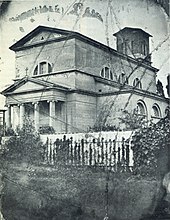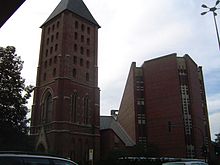St. Antonius (Wuppertal)
The St. Antonius Church in Wuppertal is the church of the oldest Catholic community in the Barmen district after the Reformation .
history
Catholics in Barmen before 1708
At the time of the Reformation the area of Barmen still consisted of individual farms and had no church. Unterbarmen belonged to Elberfeld , Oberbarmen to Schwelm . The border ran a little west of today's Old Market. In the course of the Reformation, Elberfeld was reformed , while Schwelm became a Lutheran . The few Catholics in Wuppertal were looked after by the monks of the Steinhaus monastery in Beyenburg . It was not until the Catholic Elector Johann Wilhelm , Duke of Jülich-Kleve-Berg , commissioned the Jesuits to found a "Bergische Mission". From 1682 a Jesuit priest was responsible for the then 15 Catholic families of Barmens, from 1699 a Franciscan from Hardenberg , today's Neviges . In 1705 Johann Wilhelm provided a district with 19 parcels to found a village, which was the nucleus of the later town of Barmen. The Reformed Christians of Oberbarmens separated from the Schwelmer Lutheran congregation and received permission to build the first Gemarker church in 1702 , while the sovereign gave the Catholics a piece of land as well as building materials and money to build their own church for all of Barmen.
The first church (1708-1710, 1721)
In 1708 the construction site of the future church south of the Barmer Mühlengraben , near the old market, was placed under the patronage of Saint Anthony of Padua . Due to a lack of money and material, the shell remained in place for eleven years; The church could not be completed until 1721 and consecrated on May 24th of that year. Initially 91, then in 1755 350 parishioners used the small, modest church building.
In 1748, a larger church in the Bergisch Baroque style was designed for a building site southwest of the old church, but construction came to a standstill after the foundations were laid due to the events of the Seven Years' War (1756–1763) and was never continued. With the secularization of the Franciscan monastery in Hardenberg in 1803, the time of the Barmer Mission ended, the years of French rule under Napoleon brought a time of hardship that prevented further church building plans.
The second church (1825–1826)
It was only in Barmen, which has been in Prussia since 1815 , that plans to build a larger church for the now rapidly growing Catholic community were resumed. The church, begun in 1755, seemed too small for the community, so a new design by Adolph von Vagedes for a church with 1,200 seats from the year 1818 in the years 1825-1826 was implemented. The classicist building with style elements from Roman architecture, a three-aisled, three-bay basilica without a transept with a pronaos supported by Ionic columns and a tower behind the rectangular choir in the north was consecrated on May 16, 1826.
The third church (1869-1883)
As a result of the Industrial Revolution , numerous Catholics also moved to Barmen, which finally exceeded the number of 100,000 inhabitants in 1884. As early as 1867, the congregation, which had grown to 9,000 members, began to expand its church. The Cologne cathedral master builder Vincenz Statz designed a clinkered neo-Gothic building, which added a fourth, lower one to the three bays of the old church building and connected to it a two-aisled transept and three apses . The north running Mühlenbach prevented the construction of a long choir, so that the floor plan of this church remained T-shaped. In the nineties, a massive, high Gothic tower was built in the south instead of the old portico. In 1908/09 the Angermund church painter Heinrich Nüttgens designed the interior of the church. With further church buildings for new parishes ( St. Johann Baptist in Oberbarmen 1895, Herz Jesu in Unterbarmen 1896), the population development of Barmen was taken into account. St. Antonius in Barmen-Gemarke was destroyed during the Second World War in bombing raids in 1943 and 1945 and through consequential damage, except for the lower tower floors and the outer facade of the church building; In 1947–1951 the building was makeshiftly prepared for the church service. In 1955, a new, compact tower was placed on the two remaining tower floors, which alludes to Romanesque shapes with its 56 sound openings , for example on the cathedral of Paderborn .
The fourth church (1969–1973)
In 1958 the church council decided to build a new church, the planning of which was entrusted to the architects Steinbach and Kohl in 1964. In 1968 the third Antonius Church was torn down except for the tower. The property was enlarged by exchanges and new acquisitions, the expansion to the north over the now underground mill ditch delayed construction work. The building, which was built in the 1970s and is clinkered like its predecessor, faces east for the first time and thus stands diagonally on the property; in the west there are extensive parts of the building for community work, including on the rectangular sides of the property, which form various courtyards. The three portals are located under the structural connection between the parish hall and the organ gallery. There is also a connection to the preserved south tower, which was not actually included in the new structure. The new church hall consists of a main nave, the ceiling of which rises to the trapezoidal high apse , while the side aisles are lower in the opposite direction from the west facade to the east. The ships show an open roof structure. In the west a large concrete-supported organ loft has been moved in, above which high windows on the west facade illuminate the interior of the church. In the middle and on the sides of the apse there are three narrow, high vertical windows with glass blocks.
organ
The organ of the Antonius Church was built in 1973 by the organ building company Johannes Klais (Bonn). The instrument has 48 registers on three manuals and a pedal . The disposition of the organ with its baroque Rückpositiv and the French-Romantic swell enables the performance of a wide range of organ literature. The Spieltrakturen are mechanically, the Registertrakturen electrically.
|
|
|
|
||||||||||||||||||||||||||||||||||||||||||||||||||||||||||||||||||||||||||||||||||||||||||||||||||||||||||||||||||||||||||||||||||||||||||||||||||||||||||||
- Coupling : I / II, III / I, III / II, I / P, II / P, III / P
- Playing aids : four fixed combinations, tutti, 1280-fold electronic typesetting system with sequencer and floppy disk drive, adjustable tremulants, crescendo roller .
Catholic City Church Wuppertal
Since September 11, 2004, St. Antonius has been a location of the Catholic City Church in Wuppertal alongside St. Laurentius in Wuppertal-Elberfeld .
literature
- Catholic parish St. Antonius Wuppertal-Barmen (Ed.): 275 years of St. Antonius Wuppertal-Barmen , Wuppertal 1983.
- Sigrid Lekebusch, Florian Speer : Churches and places of worship in Barmen , churches and places of worship in Wuppertal Volume 2 (= contributions to the history and local history of the Wuppertal, vol. 43), Wuppertal 2008, ISBN 978-3-87707-721-4 ( info ) .
Individual evidence
- ↑ Website on the history of the Catholic Church in Barmen ( Memento of the original from December 24, 2013 in the Internet Archive ) Info: The archive link has been inserted automatically and has not yet been checked. Please check the original and archive link according to the instructions and then remove this notice. in the portal antonius-wuppertal.de , accessed on December 22, 2013
- ↑ Detailed information on the Klais organ
Web links
Coordinates: 51 ° 16 '14.3 " N , 7 ° 11' 44" E








